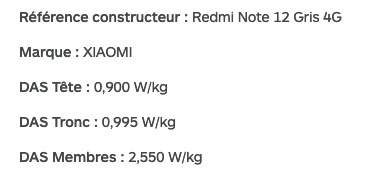Published on
Updated
Reading 3 min.
Last September, the iPhone 12 was recalled due to radio frequency emissions exceeding authorized thresholds. In fact, more than forty models from various brands were pinned after verification.
Last September, Iphone 12 users learned that their phone was emitting too many waves. But the highly publicized withdrawal was the tree that hid the forest: 44 smartphone models from several brands have also been pinned since 2017 due to exceeding the authorized specific absorption rate (SAR). And the National Frequency Agency (ANFR) had been aware of this information for at least two years.
44 models questioned
Therefore, more than 40 models from the Alcatel, Wiko, Huawei, Xiaomi, Samsung and Motorola brands have been judged non-compliant since 2017 following DAS tests carried out by the ANFR. If you have not been alerted, it is undoubtedly because the announcement gave rise to fairly discreet modifications. “In 36 cases, the manufacturer made an update to bring their phone into compliance. In six other cases, the manufacturer recalled its products. And in the last two cases, an order was issued to recall and remove the phones from the market, since the manufacturer had not taken corrective measures. explains Emmanuelle Conil, engineer for the agency. These would be the Simplicity V27 from the Emporia brand and the Doogee S88 PLUS.
Emissions that could be even higher?
Measuring SAR, however, is not easy and these radio frequencies could be even higher than expected in our smartphones. In fact, a smartphone, in real conditions, transmits on several frequencies at the same time (4G, 5G, wifi or Bluetooth). Gold, “current technologies do not allow these simultaneous emissions to be measured during the test.”, explains an industrialist to Radio France. Another limitation is that measurements are often taken 5 mm from the users’ body even though the smartphone is regularly in contact with the body (in a pocket or against the ear). Elements to be integrated into current measures and which have been requested by Anses, the National Health Security Agency since 2019.
Unfortunately, the European Committee for Electrotechnical Standardization (Cenelec), which is responsible for establishing the standards and norms that govern the performance of SAR tests, has not yet made a decision on this subject. Industrialists would also be reluctant.
What do we know about the health effects?
It is also difficult to get a precise idea of the health risks of these waves. The SAR is indeed the reference method for estimating the transmission power of the waves of a telephone (the maximum authorized SAR is 2 W/kg for the head and trunk and 4 W/kg for the limbs), but It is the International Commission for Protection against Non-Ionizing Radiation (Icnirp) which today indicates the limits not to be exceeded. However, this organization only takes into account the thermal effect in the risks, without entering into biological considerations.
However, in France, of the more than 30,000 studies identified by ANSES, many consider that exposure to radio frequencies could be associated with carcinogenic risks. In 2011, the International Agency for Research on Cancer (IARC), which depends on the WHO (World Health Organization), also estimated that radio frequencies are “possibly carcinogenic to humans”.
For ANSES, although the results may still be contradictory depending on the studies, this is an area where caution should prevail. “Because indeed, we do not have the certainty that there is no effect” testifies Olivier Merckel, head of the risk assessment unit within Anses for Radio France. A new opinion on the carcinogenic risk linked to exposure to radio frequencies should be made public in mid-2024
The fact remains that we all have a smartphone and that Christmas is also a good time to equip yourself or give a phone to your teenagers. But how can we protect ourselves, as a precaution, from these strong radio frequency emissions?
- According to ANSES, it is above all a matter of using a hands-free kit as much as possible to reduce our exposure;
- Reducing children’s exposure would also be a good measure;
- It is also possible to check on your phone the SAR that has been measured for exposure to the head, trunk and limbs. This is displayed in the settings, but often at the bottom of the list or drop-down menu.

And to protect yourself, discover our article on “The 10 good actions to avoid telephone waves”
